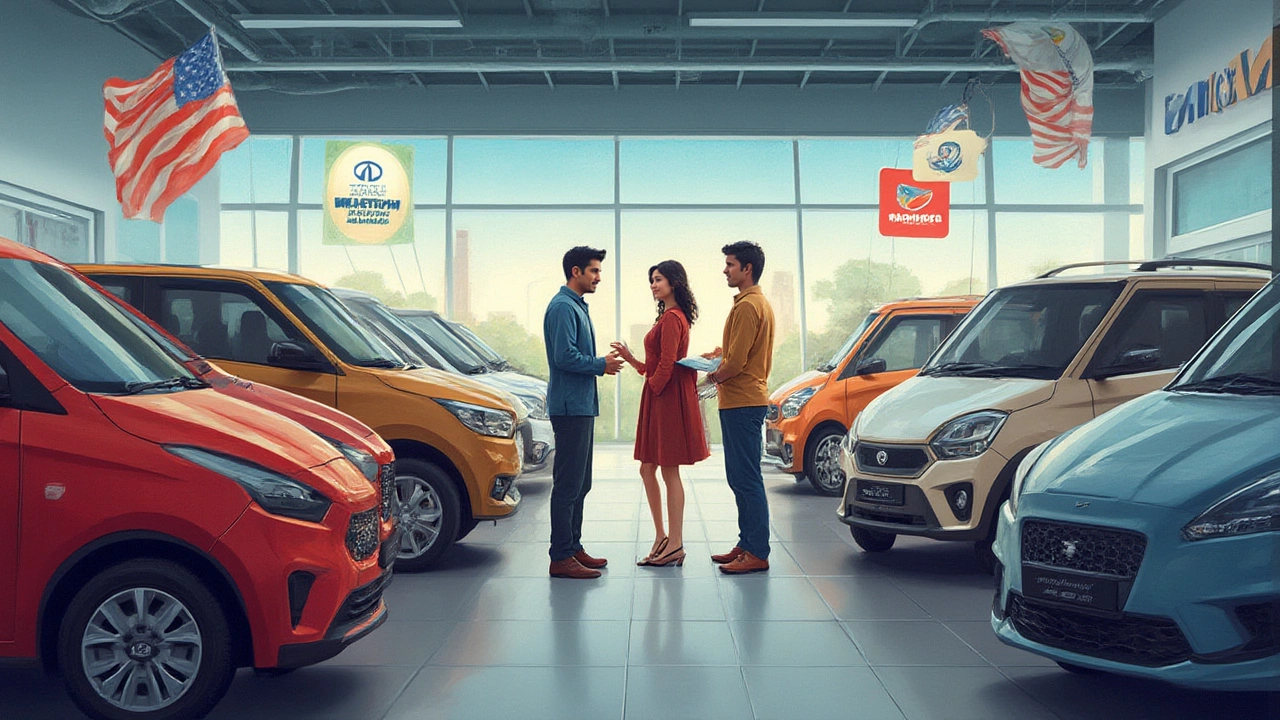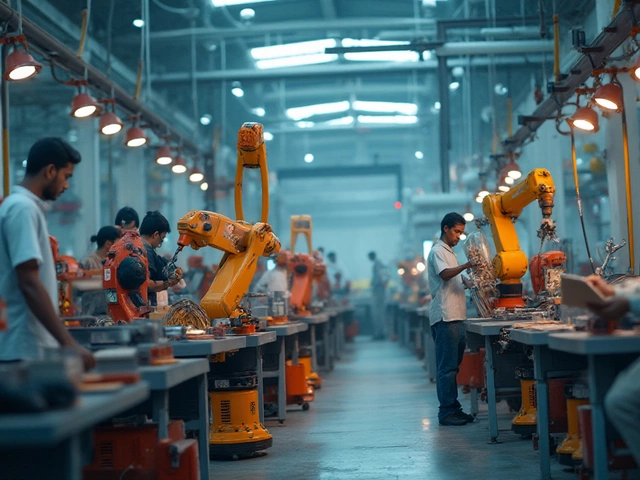Right about now, there’s a kid asking his dad—maybe even mine, Vedant—why they can't spot a Tata Nano at their local Target parking lot, or if that little Mahindra truck would be a cute first ride. After all, India is the world’s third largest car market now, and Indian SUVs and compact cars dominate their streets. So, it feels almost wild that you rarely see an Indian badge on American highways. But it isn’t just about car looks or brand logos. The story behind why you may or may not spot an Indian car parked outside your favorite burger joint goes way deeper than most people imagine—and it’s tangled up with rules, history, and some pretty interesting moves by carmakers themselves.
The Big Names: Which Indian Car Brands Are in the USA?
Ask anyone in Mumbai about Mahindra or Tata Motors and you’ll hear stories—maybe even arguments—about which brand rules the roads. These brands churn out millions of cars and trucks every year for Indian buyers. Yet, walk into any mainstream new car lot here in the USA and just try to spot a single Tata, Maruti Suzuki, or even a compact Mahindra. Spoiler alert: you probably won’t find one. The few exceptions to this rule are mostly pickup trucks or rugged vehicles from Mahindra. The Mahindra group, actually, has dipped its toes into the US market offering rugged utility vehicles, mostly for off-road, agricultural, and commercial use. Their Roxor is an interesting case—it kind of looks like an old-school Jeep Wrangler, but you’ll only see it off-highway, not on your neighborhood street.
Tata, which also owns Jaguar and Land Rover, sells those luxury British brands here, but not its actual Tata-branded passenger cars or SUVs. The Nano, which made headlines as the world’s cheapest car, never got to test its luck with American teens or bargain hunters. Maruti Suzuki, even though it’s a household name back in India, sticks to other markets. And Force Motors, Eicher, and others? Not really present in the US for daily auto sales. Sure, you'll see some Indian two-wheelers from Royal Enfield and Bajaj on the roads, but four-wheelers are largely missing in action for everyday consumers.
If you’re thinking about bringing in an Indian car yourself, it gets really complicated. Most Indian vehicles are not made to meet the US Department of Transportation (DOT) or Environmental Protection Agency (EPA) standards right off the bat. That means no easy importing for road use, unless that car becomes a “classic” (25 years or older), or it’s for off-road use only. The red tape is astonishing, from crash safety regulations to emission standards—which is why Indian brands haven’t bothered jumping through all those hoops for the mainstream, at least not yet.
So, if you ever spot a Mahindra Roxor in the wild, it’s probably being put to work on a farm, not zipping down the interstate. Fun fact: the Roxor caused enough of a buzz that Fiat Chrysler (maker of Jeep) took Mahindra to court over its Jeep-looking grill, and Mahindra had to tweak it. Shows you how even looks can get you into hot water in the car business.
Why Don’t We See More Indian Cars on US Roads?
So, what’s blocking the arrival of these wallet-friendly Indian cars in the US? The big roadblock is regulation—no surprise here. American safety and emissions rules are strict, and getting a foreign car over the finish line isn’t cheap. Indian automakers usually build cars to meet local Indian requirements, which are generally less demanding on emissions and crash safety than US standards. Retooling a whole product range just for the US is expensive, risky, and needs a mountain of paperwork.
The other part is branding and customer expectations. Indian cars, by design, are made to be affordable and efficient, not dripping with luxury or loaded with tech the way Americans expect. Remember the Tata Nano? In India, it was brilliant because it was ultra-cheap and got families out of the rain on motorbikes. Here, even a starter car is expected to have power windows, plenty of airbags, crash-test stars, and Apple CarPlay. The leap between what car buyers want in India versus America is not small. Frankly, if Tata or Mahindra sold their India-made hatchbacks here without heavy tweaks, they probably wouldn’t sell many—unless the price totally undercut every other option, which is unlikely due to all the imported tariffs and conversion costs.
It also takes decades to build a reputation in the American market. Think about Kia and Hyundai—twenty years ago, most Americans saw them as cheap, unreliable cars. Now, they’re everywhere. For Indian brands to start fresh here, they’d need patience, deep pockets, and a killer marketing plan to change hearts and minds. Some insiders have even said Tata considered launching electric vehicles in California, but backed off, fearing huge costs and regulatory headaches. It’s a cycle—lax sales expectations make for cautious launches, but until a company tries, it stays just a dream.
Adding to the challenge, American customers are spoiled for choice. Just walk through any suburban parking lot - SUVs, pickups, crossovers, sports cars from around the world, sometimes all owned by one family! Indian companies just haven’t found their angle yet that would make someone switch from their Chevy or Toyota.

Exceptions to the Rule: Indian Vehicles You Might Actually Spot
Mahindra is really the one Indian company that has gone soft-offensive in the American market, but it’s mostly through their workhorses, not daily drivers. The Mahindra Roxor caused enough of a stir in the off-highway segment that it has a dedicated fanbase among farmers, ranchers, and outdoor workers. And you’ll occasionally hear about specialized Mahindra tractors and utility vehicles quietly getting the job done on American soil.
If you dig deeper, Mahindra also once tried to sell small diesel pickups in the US, aiming to appeal to rural buyers and practical truck lovers. This was around 2010, and for a while it looked promising—everyone was watching to see if the cheap diesel truck would shake up the market. Unfortunately, due to complicated import and distribution issues, and even a messy legal battle with the company that was supposed to distribute their vehicles—not to mention changes in diesel emission rules—the project fizzled out before a single truck rolled off a US dealership lot.
There are rare cases where auto enthusiasts import older Indian models under the “25-year rule,” which allows cars not officially sold here if they’re a quarter-century old. So, you might spot a lovingly restored Hindustan Ambassador or an old Indian-market SUV at a vintage car show—that quirky, boxy look always turns heads. But these are collector’s items, not regular rides.
On the luxury side, Tata does well in the US, but not under its own name. Remember, Tata owns Jaguar and Land Rover, and those British luxury brands are everywhere here. So, in a roundabout way, Tata is already on US roads in thousands of driveways—but you’d never guess from looking at the logos. Ask any Land Rover owner if they know their car is Indian-owned, and you’ll probably get some surprised looks.
Electric and mobility startups with Indian roots, like Ather Energy and Ola Electric, have also made buzz about entering the US at some point, but as of July 2025, you just don’t see those scooters and e-bikes at scale. Maybe next year!
Future Possibilities and Tips for Indian Car Fans in America
The coolest thing about the car business? It’s always changing, and what’s true today may flip tomorrow. For fans hoping to see Indian cars go mainstream in the US, it might only take one big push or a disruptive model to start a trend. Remember the rise of compact crossovers and Japanese brands in the 1970s? No one saw it coming, and now Toyota and Honda are American classics. So if Tata, Mahindra, or even a surprise new player decides to brave the US market, things could change fast. There are rumors almost every year about Mahindra bringing electric SUVS, or Tata trying its hand at an affordable city EV. Watch this space, especially as emission rules tighten and more buyers look for budget electrics.
If you’re itching to own an Indian car in the US, here are a few realistic tips:
- Look into Mahindra’s utility vehicles and tractors—they’re the real deal if you want that Indian mechanical flavor and have a use for rugged work vehicles.
- For vintage lovers, hunt down old Ambassadors, Premier Padminis, or Mahindras that have made their way over under the classic car rule. Car enthusiast forums, eBay, and specialty brokers sometimes score rare finds—but get ready for a project.
- Stay alert for import news—global regulations are changing, and if any Indian brand finally steps up with a DOT/EPA-approved model, it’ll be all over the news. Sign up for updates directly from Mahindra or Tata USA sites; they sometimes tease new launches.
- If you just want some Indian auto DNA, consider buying a used Jaguar or Land Rover. They’re stylish, fun, and quietly supporting Indian manufacturing jobs back home in Pune and Mumbai.
- For two-wheel diehards, Royal Enfield offers a thriving range of motorcycles coast to coast. Nothing beats a Meteor or a Classic 350 if you crave that unique Indian vibe and don’t mind two wheels instead of four.
Don’t forget—Indian companies are serious heavyweights behind the scenes. Tata Steel, for example, supplies steel for Ford and GM. Indian IT giants write the software that runs your in-car navigation or safety systems. Even if the badges don’t say “Made in India,” parts of your car probably are. Crazy world, right?
Until the next Nano or Scorpio E finds a way to pass every test and wow American car buyers, keep your eyes peeled at vintage shows and farm auctions, or root for your favorite brand online. The global car market is shifting, and the day may not be far off when you’ll finally see rows of shiny Indian hatchbacks next to the Fords and Hondas at your local dealership. And when Vedant finally gets his driver’s license, maybe he’ll take his dad for a spin—in an Indian car, right here in the US.




